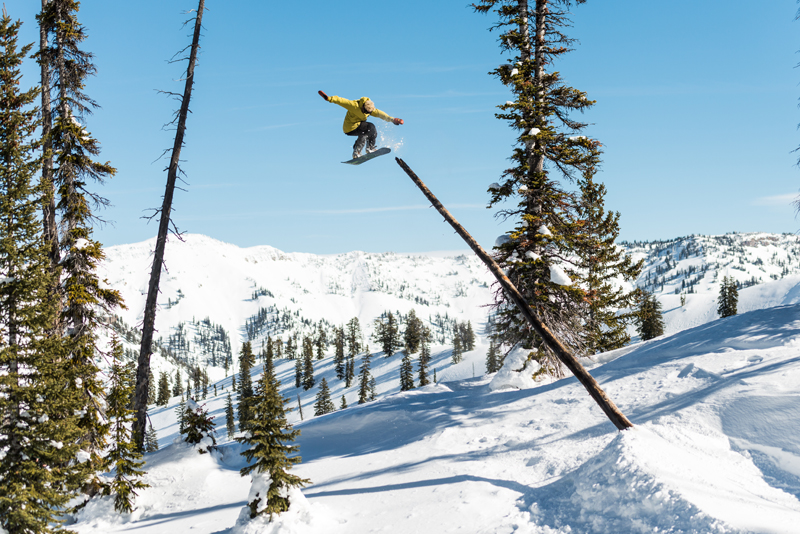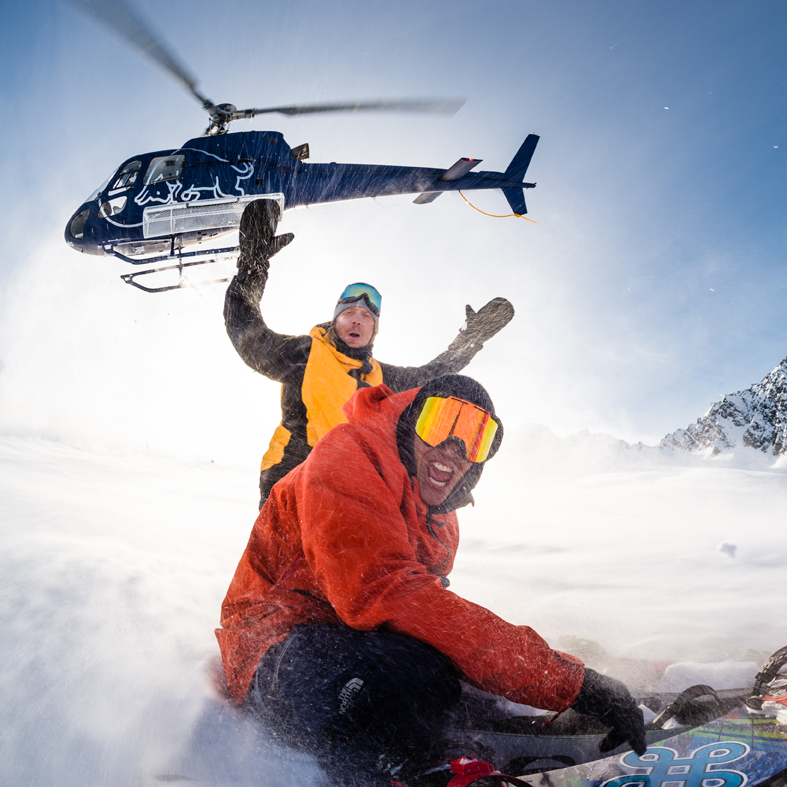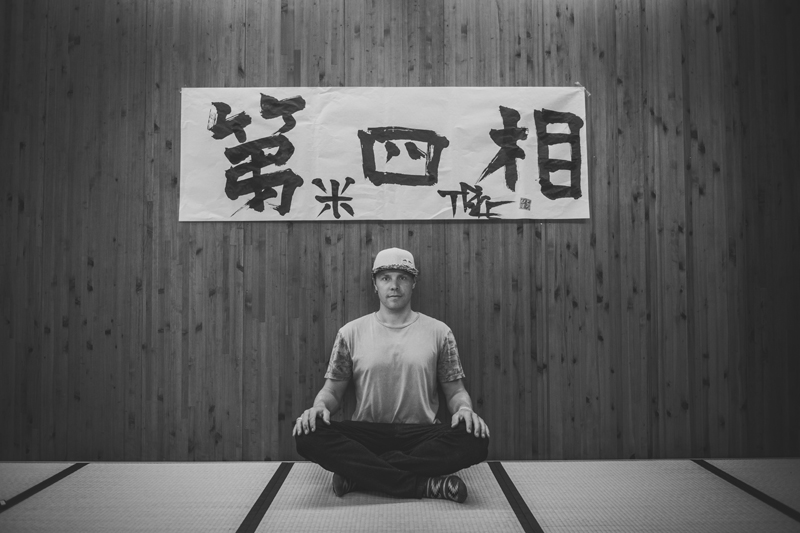“Once Travis has an idea in his head, it’s really hard for him to let it go,” understates one of his cohorts in “The Fourth Phase.” Travis Rice’s new film recently premiered in Tokyo to a packed house.
The film charts the hydrological cycle across the Pacific Ocean to Japan and beyond and marks the next step in filmmaking for him and his Brain Farm crew, which follows the tracks laid by “The Art of Flight,” and then turns inward.

Gardner Robinson: Your dad was ski patrol in Jackson Hole growing up, when did you first strap in sideways?
Travis Rice: Actually, I think it was my mom who took me skiing first, but my dad was ski patrol there, and I grew up skiing. I was 12 or 13 when I started snowboarding. I always consider myself a skier at heart; that’s how I learned to look at the mountain. For me, skiing or snowboarding, it really doesn’t matter. Personally I just much prefer snowboarding. I have more fun doing it; just that aesthetic of a turn. I think that’s really the biggest thing, the root of why I snowboard instead of ski, the nuanced beauty of the art of the turn. You can spend your lifetime working on the transition from heelside to toeside on a snowboard. I love it. You can put in a lot of effort and fine tune your ski turn, but it’s just too easy on skis.
G: Back in 2003 I remember seeing you atop the podium, spraying the crowd at the Tokyo Dome, thinking, “This kid is having a good time.”
T: Yeah, the Tokyo Dome Big Air contest (in 2003) was my first trip to Japan. I think I won it with a double back or something. Those events were fun. I was underaged, like 19 or 20, and going over to Japan in the very beginning was insane. It was amazing.
Then, when I finally got to go ride the mountains in Japan, it blew my mind. Over the last 10 years, I’ve gone up to the north island a lot. Hit all the main resorts and did a lot of roadside backcountry hiking. I know there’s so much we haven’t seen or touched up there, but it was a blast. Since then, I’m definitely into the 20s or so as far as trips to Japan.
G: Why was Japan such an important part of your latest film, “The Fourth Phase?”
T: I knew I wanted to shoot in Japan early on. Years ago, we did a Japan segment in “The Community Project,” and at the time I felt it was one of the better Japan segments ever captured. Going back to Japan, we really wanted to do it justice, spend the time and effort to bring a legitimate representation of the riding over there, the culture, the landscape; you’ve been over there for a long time, it’s a special place.
What I really like about it is you kind of get out of it what you put into it. It’s not really set up to just come and have everything at your fingertips. We really had to put in the time and effort to capture what we got. We wanted to do a little more, but it’s nice to leave something on the table as well.
The film is about water, the relationship to water and the hydrological processes that bring our weather to North America. It’s funny because Japan is on the other side of the Pacific, but it’s an essential part of the process.
We wanted to follow the North Pacific Gyre, and one of the main currents is the Kuroshio. The gyre has all that heat energy as it travels west across the Pacific, then hits a bank and gets thrust north, barrels into Japan and continues to the North Pacific. We were just following the natural energy cycle, and its first stop really was Japan.

G: What’s important to you when choosing your crew?
T: I think it mostly comes down to trying to align with people who are down with a mission and will bring optimism.
Inevitably it’s always a set-up; you go somewhere, bring your own expectations, you think you have an idea of what you want to do but then the minute you get there everything changes, so trying to work with people who are able to ride in a lot of different conditions, sub-par conditions, people who are able to make the most of any situation.
G: Instead of Hokkaido, this time you spent all your time in the Japan Alps. Why is that?
T: I did so much research on the mountains down there and, in this day and age with all the tools at your fingertips, it didn’t take long to figure out the lay of the land. I realized pretty quickly just how big and aggressive some of the mountains were down in Nagano Prefecture, which is where we spent most of our time for the new film. It was just on a whole other level, getting to experience and ride that terrain. We spent a fair amount of time in the Hakuba Valley. So many resorts have great access, but we ventured out too, we did some driving, some exotic roadside hiking and did a couple of big missions to some really incredible, straight-up peaks that reminded me of Alaska-style terrain.
I was pretty blown away by how vast and aggressive the terrain is in the Japanese Alps. You’re looking up at peaks, and it’s like Alaska seeing all kinds of amazing stuff that looks ridable, but it’s 70 percent death defying; only a small percentage really goes.
There’s a ton of terrain traps, some of the most terrain trapped mountains I’ve ridden, and just how some of those massive mountains and drainages work, you got to be on it. You really have to be on it to ride here. You get so much snow, and the weather changes all the time. It can be as good as it gets, but you have to work for it, you have to earn it.

G: Were there any specific challenges you faced filming in Japan?
T: We worked with so many good people. We did all this night shooting, and the resorts graciously allowed us to shoot, but there were all these rules and regulations. They’d be super helpful one day, but the next day we couldn’t get any help at all. It was always this funny dance. They wanted to help us out, but they had no idea how to deal with a crew as big as ours and our demands. I think at times they got a bit overwhelmed by our massive production.
It got pretty adventurous for Jared Slater, our aerial filmer. He was trying to communicate with our helicopter pilot who didn’t speak any English. They came up with six or seven key words. It is pretty difficult to capture snowboarding with normal communication, but on top of that, this guy had a little speaker in his helicopter just pumping electronic dance music while we were filming.
Other than that, I actually enjoyed getting lost in Japan’s backroads, finding myself in a wasabi farm. It was snowing, and all these guys are working in the river. I’ve been to Japan so many times, but I still constantly stumble across things that are so foreign to me.
G: How did you and Shin (Biyajima) hook up?
T: I knew Shin a little bit early on, but it’s funny because where I really met Shin, and where he made a strong impression on me, was in Jackson Hole. I sledded back to a secret zone way deep in the Jackson backcountry to some freeriding. I got out there and followed some snowmobile tracks figuring it’s just some snowmobilers.
I get way back in there and come around the corner and see two snowboard tracks and am like, holy s**t, there’re some people riding back here. I’d never seen anyone else riding back there, and it turned out to be Shin, his buddy from Jackson and Lance Pitman.
There’s this one cliff that’s pretty big, but had a fairly flat landing. I was thinking there’s no way you can land off that, but when I went back around and watched him do this line, he came down, aired this little cliff and lined up for the big one, and I was like, no way, and watched him air, kick out this massive method and then stomp the s**t out of it. I was like, who the f**k is this guy!
Shin rides down with this big ol’ Japanese grin and giggle and I’m like what? Two years later, when I started planning the trip, I knew Shin was from the Hakuba area, and I didn’t want to come film in Japan without a Japanese rider. Shin had the time and availability, and it worked out perfect.
G: You guys swung through Nozawa Onsen for Dosojin Matsuri. What were your impressions of the fire festival?
T: I really appreciated the genuine honesty of it. I’m not sure how pumped the locals are that the cat is out of the bag, widely covered with all the foreigners showing up, and it’s probably not going to help us putting a bit into our film, but I thought it was incredible and really appreciated seeing people getting some emotions off their chest.
I didn’t fully comprehend everything that was going on, but you had a sense this was a night when people were not leaving anything on the table, a night to get the skeletons out of your closet and move forward. I really liked that aspect of it.
G: For the men of the village, if it’s their year, it’s one of the biggest nights of their lives. The village is talking about cracking down on buses coming in just for the festival, which is probably a good idea. Jimmy (Chin) had his hands full trying to direct things once you all entered the mayhem.
T: The timing worked out great because Jimmy only had two months to spend with us at the beginning. It was nice to have some of his direction. He’s such an international celebrity these days, he didn’t have the bandwidth to solely direct the project, so we were pumped with the amount of time Jimmy had to put into it. He spent some time in Russia with us as well.

G: How many GoPros did you guys destroy?
T: We destroyed or lost a lot of GoPros but got a lot of incredible POV footage. In the beginning, some of the camera systems we were using were so new they weren’t on the market yet and had Beta software. We had a lot of challenges getting camera systems to work that were experimental. I’ve got to give a lot of credit to the crew who spent so much time and effort getting it right.
G: Weather being a central theme, I guess it’s fitting you had a lot thrown at you.
T: Pretty much everywhere we went we had crazy weather. I think Russia was probably one of the toughest places for us weatherwise, but even Alaska, the last three years have been somewhat subpar when you look at historically how Alaska can shape up. We had challenges the whole way through, but if it was easy, everyone would be doing it, right?
G: People might be surprised to hear you spend a lot of time on the water, but what drew you to sailing?
T: My dad really wanted to learn how to sail and, when I was 16, he became a quarter partner in this small, 24-foot trimaran. Three weeks a year, I’d go with him and we’d sail from Florida out around the Bahamas. I did that for a bunch of years and, in the meantime, I was picking up surfing, which I also fell in love with. Then I was like, man, to combine the two would be perfect.
I find I enjoy myself most on those days when it’s just me and a couple close friends away from it all. True human interaction in a day when we are all spread so thin. Over the past six years, my girlfriend and I live on our boat two or three months a year. It’s just one of our seasonal homes at this point.
G: Do you find similarities between being deep in the mountains and the sea?
T: Being out on the ocean seems like a different world to being in the mountains and the backcountry, but there is also a lot of symmetry. They each have their own biorhythms from a motherly embrace to tempestuous wrath. What I love about being out in nature is that you are at the mercy of your own decision making.
G: Now that “The Fourth Phase” is in the books, do you look back at your past films any differently?
T: They were all just chapters in the book, stepping stones. Each was perfect for where we were at the time, and I’m proud of them all. We couldn’t have done this film without the other films pre-dating it and being part of the process. We needed to do “Community Project” to feel comfortable doing our own thing, and then “That’s It That’s All” was this experiment with camera technology and shooting snowboarding a little differently. “Art of Flight” was that dream of “That’s it That’s All” realized. Then we didn’t want to make an “Art of Flight 2,” so we stepped back and tried to take a different approach to create a more multi-faceted film. “The Fourth Phase” has more of a storyline, and it was much more personal for me.
It’s probably the most personal project I’ve done, which changed the dynamic a little bit. Plus we were involving more than just snowboarding in the project. We were looking at weather and our relationships with weather. It goes to a few other places, and I don’t want to spoil anything, so I won’t go into it, but it’s about a willingness to expose oneself a little bit more and share something openly and honestly. It’s more than just landing tricks. Moving forward, this is just another stepping stone…
G: And what is next?
T: What’s next? I don’t know. Right now, I’m really interested in revamping the Supernatural contest, so I’m going to put a lot of effort and energy into that going forward. The only thing I’d say is that it would be really nice to have a venue stop in Japan someday. Japan would be perfect for it.




